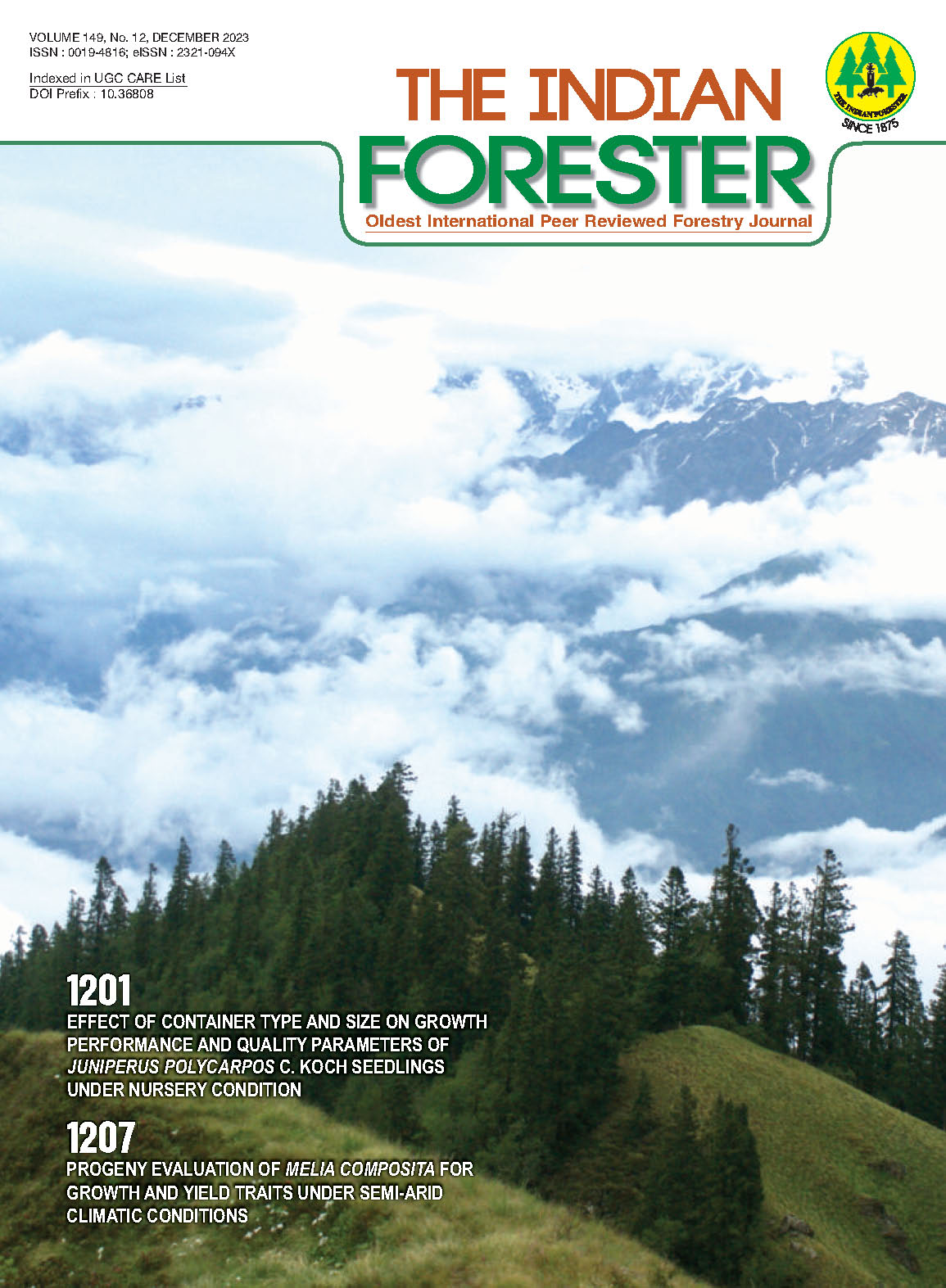Assessment of Oleoresin Biosynthesis in Epithelial Cells of Pine Resin Ducts: A Case Study from Narendranagar Forest Division; Uttarakhand, India
DOI:
https://doi.org/10.36808/if/2023/v149i12/169813Keywords:
Oleoresin, Epithelial Cells, Resin Ducts, Narendranagar Forest Division.Abstract
Pinus roxburghii is one of the most important tree species used for resin tapping and for commercial purpose in Uttarakhand. Resin tapping in Pinus roxbughii has revealed that the anatomical factors greatly affect the production potential of Oleoresin. Production potential of Oleoresin is directly correlated with anatomical characteristics like number of epithelial cells, vertical and horizontal resin along with the diameter of resin ducts. On the other hand, Oleoresin production is also directly correlated with chemical stimulants concentration, growth rate, height, age, canopy, number of bore-hole, diameter of tree. The present study aimed at presenting the role of anatomical parameters in Oleoresin production potential in Narendranagar forest division. The enumeration of 75 tree of Chir-pine categorized on the basis of Oleoresin production potential of anatomical features into HRY'S, MRY's and LRY's. The study revealed maximum number of epithelial cells was recorded in vertical resin ducts in tree, T-02 (22) and horizontal resin ducts in T-01, T-02, T-05, T-10,T-16 and T-60 (12) in HRY'S, Tree of Chir-pine. On the other hand, maximum number of horizontal resin ducts/mm2 was recorded for T-60 (3.0) whereas the diameter of vertical resin ducts (µm) was maximum recorded in tree number, T- 02 (297.0) in HRY'S. The other two categories Viz. MRY's and LRY's showed moderate number of epithelial cells, vertical and horizontal resin along with the diameter of resin ducts resulting into less yield of Oleoresin. However, more research is needed on the morphological and anatomical parameters to understand the role of resin canal and ducts in Oleoresin formations. It was observed that the wood of Pinus is characterized by the presence of various longitudinal resin canals in the early and latewood which are further interconnected with the resin canals. Present study also recorded more resin canals in latewood than the early wood in a given annual ring.References
Biswas C. and Johri B.M. (1997). The Gymnosperms. New York: Springer- Verlag.
Chattawrmy M. (1951). The development of horizontal canals in rays. Aust.J. scient. Res., B4: 1-11.
Chattawry M.M. (1951). The development of horizontal canals in rays. Austin Journal of. Scientific Research, B4: 1-11
Coppen J.J.W. and Hone G.A. (1995). Non-wood forest products. Vol. 2. Natural Resources Institute, FAO, Rome, Italy.
Dudareva N., Pichersky E., Gershenzon G. (2004). Biochemistry of plant volatiles. Plant Physiol. 135: 1893–1902.
Fahn A. and Benayoun J. (1976). Ultrastructure of resin ducts in Pinus halepensis development, possible sites of resin synthesis, and mode of its elimination from the protoplast. Annals of Botany, 40(4): 857-863.
Ferreira A.T.B. and Tomazello-Filho M. (2012). Anatomical aspects of resin canals and oleoresin production in pine trees. Research Signpost, 37/661 (2): 9-24.
Helmers A.E. (1943). The ecological anatomy of ponderosa pine needles. American Midland Naturalist, 55-71.
IAWA Committee. (1964). Multilingual glossary of terms used in wood anatomy, Leiden, 185.
Jeffrey E.C. (1905). The Comparative Anatomy and Phylogeny of the Coniferales: Part 1-[2] (Vol. 6, No. 1-4).
Kelkar V.M., Geils B.W., Becker D.R., Overby S.T. and Neary D.G. (2006). How to recover more value from small pine trees: Essential oils and resins. Biomass and Bioenergy, 30(4): 316-320.
Kibblewhite R.P. and Thompson N.S. (1973). The ultrastructure of the middle lamella region in resin canal tissue isolated from slash pine holocellulose. Wood science and technology, 7(2): 112-126.
Larson P.R. (2012). The vascular cambium: development and structure. Springer Science & Business Media.
Lee H.J., Ravn M.M. and Coates R.M. (2001). Synthesis and characterization of abietadiene, levopimaradiene, palustradiene, and neo abietadiene: hydrocarbon precursors of the abietane diterpene resin acids. Tetrahedron, 57: 6155–6167.
Martin D.M., Gershenzon J. and Bohlmann J. (2003). Induction of volatile terpene biosynthesis and diurnal emission by methyl jasmonate in foliage of Norway spruce. Plant Physiol., 132: 1586–1599.
Mayr H. (1884). Entstehung und Vertheilung der Secretions-organe der Fichte und Larche. Botan. Centr., 20: 308-310.
Munch E. (1919). Naturwissenschaftliche Grundlagen dcr Kiefernharznutzung. Bid. Reich. Land- Forstwirtschaft, 10: 1-140.
Napp-Zinn K. (1966). Anatomie des Blattes. I. Blattanatomie der Gymnospermen. Berlin-Nikolassee: Gebrüdder Borntraeger.
Pio C.A. and Valente A. (1998). Atmospheric fluxes and concentrations of monoterpenes in resin-tapped pine forests. Atmos. Environ., 32: 683–691.
Sharma O.P. (2002). Efficient resin tapping and its processing in Himachal Pradesh: An overview. Indian Forester, 128(4): 371-378.
Sheue C.R., Yang Y.P. and Kuo-Huang L.L. (2003). Altitudinal variation of resin ducts in Pinus taiwanensis Hayata (Pinaceae) needles. Botanical Bulletin of Academia Sinica, 44: 683–691
Thomson R.B. and Sifton H.B. (1926). III. Resin canals in the canadian spruce (Picea canadensis (Mill.) BSP)-An anatomical study, especially in relation to traumatic effects and their bearing on phylogeny. Philosophical Transactions of the Royal Society of London. Series B, Containing Papers of a Biological Character, 214(411-420): 63-111.
Tiwari S.P., Kumar P., Yadav D. and Chauhan D.K. (2013). Comparative morphological, epidermal, and anatomical studies of Pinus roxburghii needles at different altitudes in the North-West Indian Himalayas. Turkish Journal of Botany, 37(1): 65-73.
Vant Tieghem (1872). MCmoire sur les canaux sCcrCteurs des plantes. Annls. Sci. nut., 5e Sir.,Bot., 16: 96-201.
Wimmer R. and Grabner M. (1997a). Anatomical aspects of resin canals and oleoresin production in pine trees, Trees – Structure and Function, 11: 5, 271.
Wimmer R. and Grabner M. (1997b). Effects of climate on vertical resin duct density and radial growth of Norway spruce [Picea abies (L.) Karst.]. Trees, 11(5): 271-276.
Downloads
Downloads
Published
How to Cite
Issue
Section
License
Unless otherwise stated, copyright or similar rights in all materials presented on the site, including graphical images, are owned by Indian Forester.





